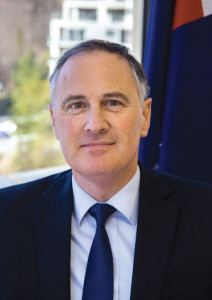I am proud to present the Airservices 2019-20 Corporate Plan, my first as Chairman of Airservices Australia. I consider it a great honour to chair this organisation as we move towards a different future for both Airservices and Australia’s aviation industry.
Air traffic continues to grow, with Australia’s capital cities forecast to more than double their conventional aircraft movements over the coming two decades. The nature of air traffic is changing and becoming more complex as remotely piloted and unmanned aircraft systems-such as drones-and other innovators enter our airspace. As a nation we are investing heavily in the airport and aviation infrastructure required to support this growth. Meanwhile, the continuing rate of acceleration of technological change is transforming aviation at all levels.
This year’s plan builds on the themes of the previous three years of industry leadership, service innovation, service excellence and organisational agility. Our work program is very much focused on delivering outcomes for our customers and industry, while minimising the community and environmental impacts of our operations.
We also remain committed to evolving as an organisation. We are becoming more agile and maintaining productive operations to ensure that we can continue to deliver safe and efficient services to all who make use of Australia’s changing skies.
The work we have done internally since 2017 to make Airservices more efficient is now helping to support the long-term growth of Australia’s aviation industry. I am pleased to announce that on 1 July 2019 we passed on a price reduction of two per cent, following several years of zero price increases. For our customers, this represents a real price decrease of 20 per cent by the end of this plan.
In 2019-20 we will once again waive up to approximately $2.5 million in annual service charges for Australia’s not-for-profit aeromedical providers. These operators provide vital services in remote parts of Australia and we are always pleased to offer our support.
While delivering these financial benefits for the industry, we are continuing to execute our $1.2 billion capital investment program. This is underpinned by OneSKY but also supports delivery of new airport infrastructure, services to regional Australia and the digital transformation of our operations.
OneSKY remains the cornerstone of our commitment to deliver world-class air traffic management services into the future. Airservices is working closely with our partners in the Department of Defence, as together we introduce a truly harmonised civilian and military air traffic management system. This will transform air traffic management in Australia and improve the safety and efficiency of our skies for the benefit of industry and the Australian economy. In the coming year our focus is on harnessing the benefits of our new voice communication switch, ensuring our new air traffic services centres are ready for installation, and concluding the system design review, as we prepare for the new system to go live during the five-year life of this plan.
OneSKY’s customer service delivery benefits will be complimented by programs to enhance our network air traffic flow management, including airport collaborative decision making (A-CDM) and long-range air traffic flow management (LR-ATFM).
A-CDM will provide Airservices, our customers and industry partners-including airports-with real-time operational data, which will help reduce delays and operating costs. The program will track towards service readiness in 2019-20.
Meanwhile, LR-ATFM is on-track for implementation at Melbourne Airport in late 2020, with Brisbane, Sydney and Perth airports to follow. This initiative will deliver a range of operational, economic and environmental benefits, including reduced aircraft fuel burn and enhanced air traffic predictability.
We have established a program of work to ensure that our aviation rescue fire fighting service is well positioned for the future, as we bring on a new fire service at Whitsunday Coast Airport in 2019-20.
We are managing the introduction of remotely piloted and unmanned aircraft systems-as well as other low-altitude airspace entrants into Australian airspace-safely and efficiently. We have commenced a program to rapidly assess the capability and functionality of unmanned traffic management (UTM) systems, and to understand how we must adapt to accommodate the rapidly changing landscape of low altitude airspace.
This organisation’s proven ability to deliver safe and efficient services, coupled with our vision for Australia’s high-tech aviation future, leaves us well-positioned to meet the challenges that lie ahead for the industry. This plan outlines how we intend to rise to those challenges in the coming year and beyond, and how we will ensure that all those using our skies remain safe.
As Chairman of Airservices Australia,
I present the Airservices Australia 2019-20 Corporate Plan, which covers the period of 2019-20 to 2023-24, according to s.35(1)(b) of the Public Governance, Performance and Accountability Act 2013 (Cth) and s.13 of the Air Services Act 1995 (Cth).
John Weber

